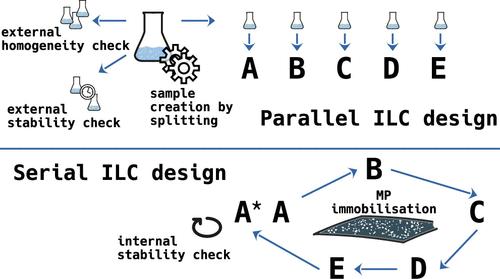什么是不应该移动的:固定微塑料作为分析环试验的新方法
IF 11.3
1区 环境科学与生态学
Q1 ENGINEERING, ENVIRONMENTAL
引用次数: 0
摘要
微塑料作为普遍存在的环境颗粒污染物已经变得越来越重要。它们的分析需要精确的量化方法,其中实验室间比较(ILCs)对性能评估至关重要。通常,ILC遵循平行设计:参与者各自分析自己的样品标本,由于在产生相同的颗粒分析物子样品方面的挑战,通常具有显着的变异性,不可分割地掩盖了ILC打算测量的相关不确定性源。我们为≤100 μm的颗粒提供了一种过滤固定化方法,创造了永久固定化的微塑料样品。这使得串行ILC设计,参与者依次测量相同的样本。通过将5种聚合物固定在孔径为10 μm的硅滤光片上,我们证明了这一概念,其测量不确定度比在平行ILC中观察到的总不确定度低77%(相对标准偏差分别为5%和23%)。颗粒固定化在样品存档和持久参考样品的创建方面也为微塑料以外的其他颗粒物质研究领域开辟了进一步的应用。本文章由计算机程序翻译,如有差异,请以英文原文为准。

What Goes Around Should Not Move Around: Immobilizing Microplastics as a New Approach for Analytical Ring Trials
Microplastics have gained importance as pervasive environmental particulate pollutants. Their analysis demands precise quantification methods, with interlaboratory comparisons (ILCs) being crucial for performance assessment. Typically, ILCs follow a parallel design: participants each analyze their own sample specimen, often with significant variability due to challenges in producing identical subsamples of the particulate analyte, inseparably masking the relevant uncertainty sources the ILC intends to measure. We provide a filtration-immobilization approach for particles ≤100 μm, creating permanently immobilized microplastics samples. This enables serial ILC designs where participants sequentially measure the same sample. Demonstrating the concept using 5 polymers immobilized on 10 μm pore-sized silicon filters, we expose the specific measurement uncertainty being 77% lower than the total combined uncertainty observed in a parallel ILC (relative standard deviations: 5 and 23%, respectively). Particle immobilization opens further applications in sample archiving and creation of durable reference samples also for other fields of particulate matter research beyond microplastics.
求助全文
通过发布文献求助,成功后即可免费获取论文全文。
去求助
来源期刊

环境科学与技术
环境科学-工程:环境
CiteScore
17.50
自引率
9.60%
发文量
12359
审稿时长
2.8 months
期刊介绍:
Environmental Science & Technology (ES&T) is a co-sponsored academic and technical magazine by the Hubei Provincial Environmental Protection Bureau and the Hubei Provincial Academy of Environmental Sciences.
Environmental Science & Technology (ES&T) holds the status of Chinese core journals, scientific papers source journals of China, Chinese Science Citation Database source journals, and Chinese Academic Journal Comprehensive Evaluation Database source journals. This publication focuses on the academic field of environmental protection, featuring articles related to environmental protection and technical advancements.
 求助内容:
求助内容: 应助结果提醒方式:
应助结果提醒方式:


